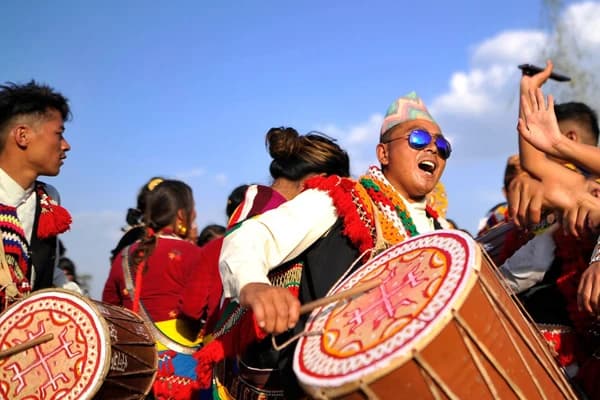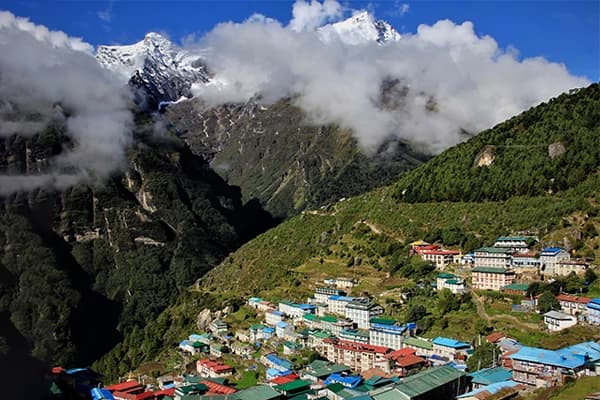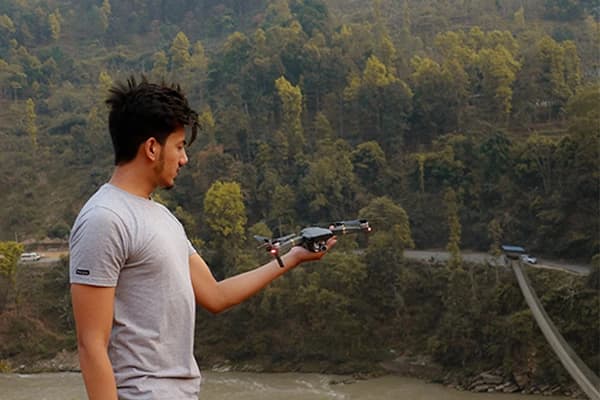Location and Accessibility
Annapurna Base Camp is located in the Annapurna Conservation Area within the Himalayan region of north-central nepal. The precise coordinates of the ABC are approximately 28° 31' 50'' North, 83° 52' 42'' East. It is surrounded by peaks like Annapurna I, Machhapuchhre, and Hiuchuli.
The camp is accessible by the multi-day trek starting from Nayapul, Kimche, or Ghandruk. To reach there, you can take a taxi or the jeep from Pokhara. From pokhara, it is just 1 hour to Kande, 2 hours to Tikhedhunga, and 4-5 hours to Kimchi or Ghandruk.
The duration and distances may be different depending upon the itinerary chosen or customized. So, it's up to you what types of experiences you want.
If you are planning your journey from Kathmandu, then you will need to take the flight or the vehicle that takes you to Pokhara city. The flight is just half an hour long, while traveling by land may take around 6-8 hours depending upon the traffic and route conditions.
Camping option at Annapurna Base Camp
Camping can be fun as well as adventurous. Camping in the Annapurna Base Camp offers several options, including traditional camping, teahouse camping, and guided camping. The facilities at the Annapurna Base Camp can vary depending upon the camping options you choose.
Below are camping options with the facilities each option has.
- Guided Camping Treks (with full camping gear and support)
Several trekking and outdoor agencies offer guided camping trips that include tents, sleeping bags, mats, and all necessary camping gear, as well as support staff to handle logistics and meals. The facilities are basic. This is a thrilling way to experience the attractions at the Annapurna Base Camp.
In this camping trip, all the preparations are done by the professionals, and you will get ample time to enjoy the trip. However, the challenges are still there. The facilities are very basic, and you have to survive there.
- Teahouse Camping (using teahouse facilities for meals and shelter, with optional tent use)
Some teahouses also offer camping other than the regular teahouse accommodation. It gives a new approach to the abc trek. All the facilities are similar to the teahouse facilities.
Some trekkers also try the hybrid approach. For example, they bring their own tent, camp near the teahouses, use their facilities like food and showers, and spend the time in the camp. It allows the trekkers to enjoy the outdoors while having access to hot food and communal spaces.
The main drawback is that camping aspects and facilities are limited. Also, the space for pitching a tent can be scarce, especially during the peak season.
- Independent Camping (self-arranged, with rented or personal gear)
This camping is the traditional way and most loved by the trekkers. In this camping, trekkers manage all the things, including facilities. They rent or bring their own camping equipment—tents, sleeping bags, and mats—to the trek’s starting point and carry it all along to the Annapurna Base Camp.
It gives flexibility and solitude. However, all the comforting and useful gear needs to be carried by you. The facilities are very limited, including no shower option, limited food, limited dining area, and so on.
Activities and attractions
Either in the campground or during the journey to the Annapurna Base Camp, you can do several activities and enjoy the attractions. The activities include trekking, hiking to the nearby religious sites on acclimatization days, bird watching, exploring the langtang region villages, and so on.
The base camp itself is a place of serenity. The place is perfect for nature lovers and adventurers. From there, you can enjoy the 360 views of the Annapurna range. If you choose to stay overnight or camp there, stargazing can be an excellent activity to enjoy.
Several trekking routes take you to the Annapurna base campground. The journey itself is one form of the activity commonly called trekking.
During the trekking, you will cross through several villages. The explorations of the villages offer you the cultural immersion of the Gurung and Magar communities along with the chance to experience their hospitality.
The villages are home to several historical and religious attractions too. Some of the popular sites include Chomrong Monastery, Jhinu Danda Monastery, and numerous small Hindu temples and shrines.
While there is not a residence exactly at the Annapurna Base Camp, the nearby areas have inhabitants of the culturally rich Gurung and Magar communities. There, you will get to experience the warm hospitality, taste their unique cuisines, interact with them, listen to their stories, learn their local customs, observe their lifestyles, and much more.
The trekking routes are also open for activities like trekking and hiking. The national as well as international tourists visit the place to enjoy the thrilling trek and hikes. The treks and hikes come with several opportunities.
Best Time to Visit Annapurna Base Camp
The best time to visit the Annapurna base camp is during spring (March to May) and autumn (September to November). Both seasons offer pleasant and stable weather conditions, clear skies, and favorable temperatures for outdoor adventures like trekking and hiking.
The spring offers warm days and chilly nights. During the days, the terrain surrounding the Annapurna Base Camp is covered with the colorful rhododendron and other wildflowers. The sunrise and sunset views of the snow-capped peaks can be seen clearly.
The autumn also offers similar conditions to the spring season. The views of the snow-capped peaks can be seen clearly. The flower bloom cannot be seen during autumn. But, in an advantage, the season coincides with the festivals, offering more cultural immersion opportunities.
The other seasons, like monsoon and winter, are not recommended for visiting the ABC. It is because winter comes with the colder temperatures and snowfall, and the monsoon comes with the heavy rainfall and slippery trails.
Essential Packing List for Campers
- Clothing like moisture-wicking thermal tops and bottoms, fleece or down jackets/sweaters, and waterproof and windproof jackets and pants Trekking pants, long and short sleeves, a warm hat/beanie & gloves, a sun hat or cap, a neck gaiter or buff, and underwear and sleepwear.
- Footwear items including camp shoes or sandals, synthetic trekking socks, and trekking boots.
- Technical gear like a 50–70 L main backpack, a 20–30 L day backpack with rain cover, a -10°C (14°F) rated sleeping bag, a sleeping bag liner, trekking poles, a headlamp/head torch, and so on.
- Personal items including water bottles, water purification, towels, toiletries (toothbrush, toothpaste, biodegradable soap, shampoo, deodorant, wet wipes, hand sanitizer, and feminine hygiene products), sunscreen & lip balm, toilet paper & tissues, and snacks (energy bars, nuts, and dried fruit).
- Electronics items like power banks, universal adapters & charging cables, cameras, and sunglasses.
Environmental Considerations
Environmental considerations are something that trekkers visiting the ABC should take care of. During the trekking, the Annapurna region faces increasing ecological stress due to the high volume of visitors. Below are the key considerations.
The attraction of the trekkers to the Annapurna Base Camp also leads to the increase of waste production, especially plastic and non-biodegradable materials. These wastes are difficult to manage in the remote areas.
The trekkers themselves must be responsible for their respective waste. They need to dispose of the waste in the designated sites. The local organizations are also working to manage the waste in the Annapurna region, but the trekkers also have the responsibility to manage at least their own litter.
- Ecosystem and Biodiversity Protection
Sometimes, the trekking activities may disrupt the habitats and threaten the native species. We are the aliens to the animals residing in the forest environment. The flora ecosystem also gets disturbed if we walk from the unestablished trails just for adventure.
For the protection of the natural elements of the ecosystem, we should stay on the established trails and avoid picking plants or disturbing wildlife.
- Deforestation and Energy Use
Deforestation was a concern due to the use of the cutting of trees for fuel by the teahouses. As of now, the problem is reduced due to the regulations.
In this matter, the trekkers and trekking agencies should support lodges and tea houses that use sustainable energy sources rather than the practice of cutting trees.
The increased tourism can put pressure on the local water resources and sanitation facilities. It can lead to pollution if trekkers start behaving irresponsibly.
These issues can be solved when trekkers use the biodegradable soaps, avoid polluting water sources, and use the toilets provided at the tea houses.
This issue also leads to the creation of new shortcuts and avoiding the single file on the established trails. This led to the trail erosion, especially on the dirt paths. The erosion can cause the sediments to enter the waterways. So, minimization of this impact is necessary.
- Cultural Respect and Regulations
Respecting the local cultures and traditions and following the regulations is important. The trekkers need to dress modestly, ask permission before photographing people or religious sites, and follow local customs.
Furthermore, the trekkers must obtain the Annapurna Conservation Area Permit (ACAP) and a TIMS card. The funds collected from the permits help ensure responsible tourism and also support the local economy.
Conclusion
So, this season, try to visit Annapurna Base Camp. It is more just a journey. This adventure promises breathtaking scenery, rich cultural encounters, and a profound sense of achievement.





